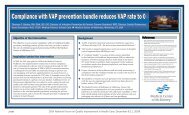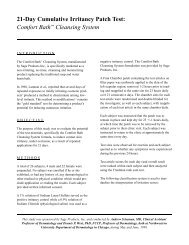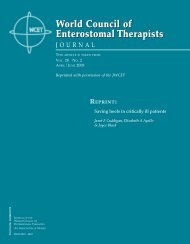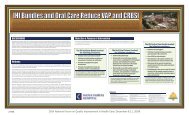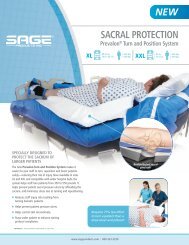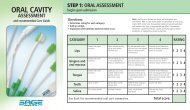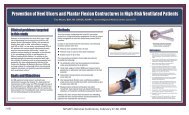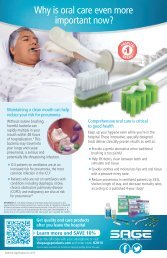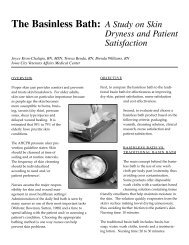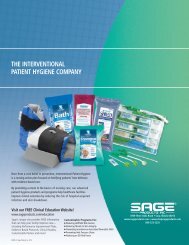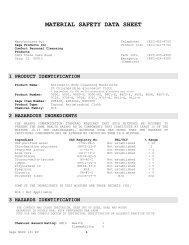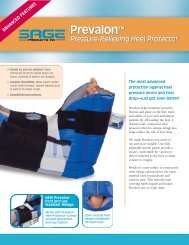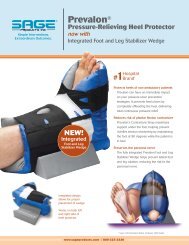Download handout (.pdf*) - Sage Products Inc.
Download handout (.pdf*) - Sage Products Inc.
Download handout (.pdf*) - Sage Products Inc.
- No tags were found...
Create successful ePaper yourself
Turn your PDF publications into a flip-book with our unique Google optimized e-Paper software.
Ongoing Quality Improvement: C-Section SSIPrevention Efforts Successful in a Community HospitalThomas C. Button, RN, CNA-BC, CIC, Director of Infection Prevention & Control;Carla Rider, RNC, BSN, Director Women’s and Children’s Services u Medical Center of McKinney, McKinney, TX, USAThe World Health Organization2005 survey reported that womenwho have cesarean sections(C-sections) are 5 times morelikely to develop a postpartuminfection than are women whohave vaginal deliveries, 1 andthe incidence of surgical siteinfections (SSIs) with C-sectionsranges from 1.50 to 2.64. 2 SSIprevention is multifactorial andrequires ongoing assessmentfor quality control. This qualityimprovement initiative wasthe result of an intensive chartreview by the Infection ControlDepartment of the MedicalCenter of McKinney after it wasnoted in 2006 that the SSI rateassociated with C-sections wasabove national benchmarks.The chart review revealed that themajority of patients with C-sectionrelatedSSIs were morbidly obesemothers with no documentationthat they had showered the nightbefore surgery, as recommended bythe Centers for Disease Control andPrevention (CDC) 3 for emergentand non-emergent patients. TheInfection Control Departmentrecommended standardization ofthe preoperative skin antisepsisprotocol, which incorporatedwhole-body skin preparation thenight before surgery. Furthermore,on 02/14/07, the use of 2%chlorhexidine gluconate (CHG)became the standard of care forintraoperative skin antisepsis.Although the SSI rate decreasedin 2007 compared with 2006,C-section-related SSIs still occurred.Therefore, the Infection ControlDepartment conducted anotherintensive chart review. This reviewrevealed that emergent patientsarriving for C-sections were unableto receive the recommendedwhole-body skin preparation thenight before surgery; therefore,the protocol was modified toensure that prior to undergoingthe standard preoperative skinantisepsis, patients would receivewhole-body skin preparation with2% CHG non-rinse cloths in theLabor and Delivery area. Thisadditional preoperative preparationmeasure was added to the ordersheets for all patients undergoingC-sections in August 2008 to ensureprotocol compliance.In addition, elective C-sectionpatients were provided the option ofusing the 2% CHG non-rinse clothsfor whole-body skin preparation thenight before surgery, in additionto undergoing whole-body skinpreparation in the Labor andDelivery area; this provided anadditional opportunity for skinprepping. By the end of July 2009,the quality improvement effort hadresulted in a relative reduction inSSIs of 73%.References1. Villar J, Carroli G, Zavaleta N, et al; World HealthOrganization 2005 Global Survey on Maternaland Perinatal Health Research Group. Maternaland neonatal individual risks and benefitsassociated with caesarean delivery: multicentreprospective study. BMJ. 2007;335(7628):1025.Epub 2007 Oct 30.2. Edwards JR, Peterson KD, Andrus ML, et al; theNational Healthcare Safety Network Facilities.National Healthcare Safety Network (NHSN)Report, data summary for 2006 through 2007,issued November 2008. Am J Infect Control.2008;36:609-626.3. Mangram AJ, Horan TC, Pearson ML, Silver LC,Jarvis WR, the Hospital Infection Control PracticesAdvisory Committee. Guideline for prevention ofsurgical site infection 1999. Infect Control HospEpidemiol. 1999;20:247-280.21st National Forum on Quality Improvement in Health Care: December 6-9, 200921313Reprints provided compliments of <strong>Sage</strong> <strong>Products</strong>, <strong>Inc</strong>.800-323-2220 • www.sageproducts.com
Fisher’s exact test was used to assess thechange in SSI infection rates over time. Thetime period for data analyses was 1 yearbefore and 1 year after the protocol wasmodified to incorporate whole-body skinpreparation with 2% CHG non-rinse clothsthe night before surgery and/or whole-bodyskin preparation with 2% CHG non-rinsecloths in the Labor and Delivery area prior tostandard preoperative skin antisepsis. Countsand percentages were presented for SSI rates.The data analysis revealed SSI rates of 1.5before the intervention (7/459) and 0.4 afterthe intervention (2/488), reflecting an absolutereduction of 1.1% and a relative reduction of73% (Figure 1).Figure 1. SSI <strong>Inc</strong>idencePre- and Post-InterventionSummary of Results/Lessons LearnedImplementation of a quality improvement program requiresa review of the evidence-based literature and best practices,strategic change management strategies, and intensive caregiverand physician education to ensureprotocol compliance.The reduction in SSIs began in 2007 as a result of modifyingthe preoperative skin antisepsis product to 2% CHG and 70%isopropyl alcohol at the same time that we incorporated 2%CHG non-rinse cloths for whole-body skin preparation thenight before surgery.# of SSI by monthPre-intervention1.5 SSI rate (7/459)Post-intervention0.4 SSI rate (2/488)73% relativereduction in SSI rateP = .10An additional chart review revealed that emergent C-sectionpatients were not able to receive the whole-body skinpreparation regimen the night before surgery; therefore, wholebodyskin preparation with 2% CHG non-rinse cloths wasperformed in the Labor and Delivery area and was added to thepatient order sheet, which ensured protocol compliance.Enabling elective C-section patients to use the 2% CHG nonrinsecloths for whole-body skin preparation at home the nightbefore surgery, in addition to undergoing a second whole-bodyskin preparation in the Labor and Delivery area, provides anadditional opportunity for skin preparation preoperatively.Pre-InterventionPost-InterventionOpen communication between departments and the gradualaddition of SSI-prevention strategies helped to improvethe effectiveness of individual practices and facilitated ourprevention efforts.



